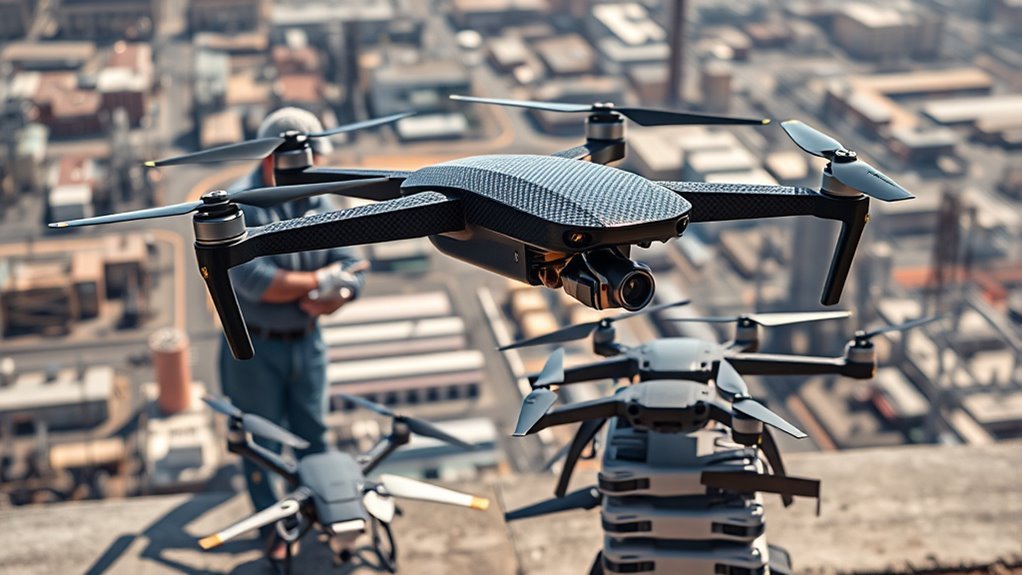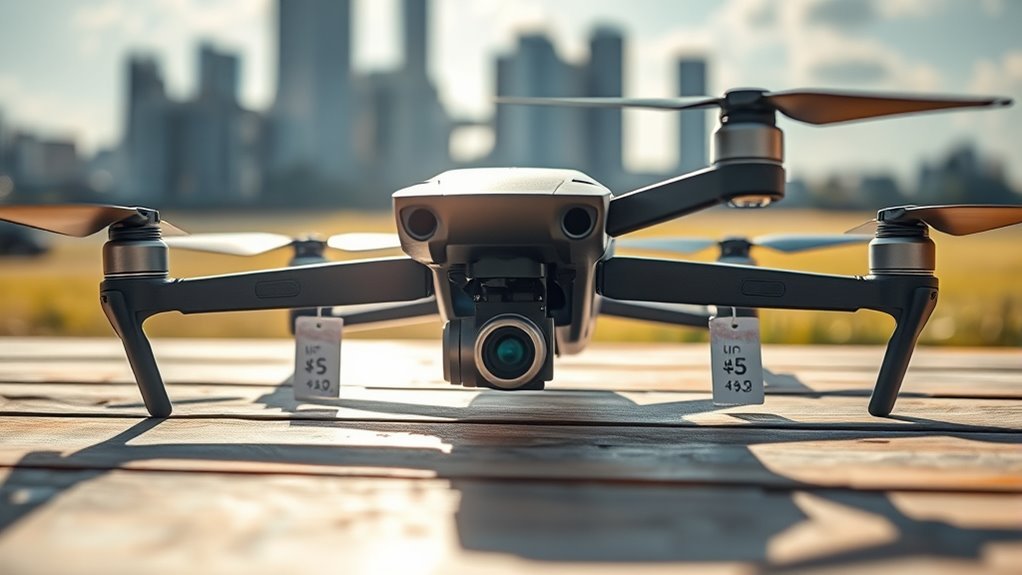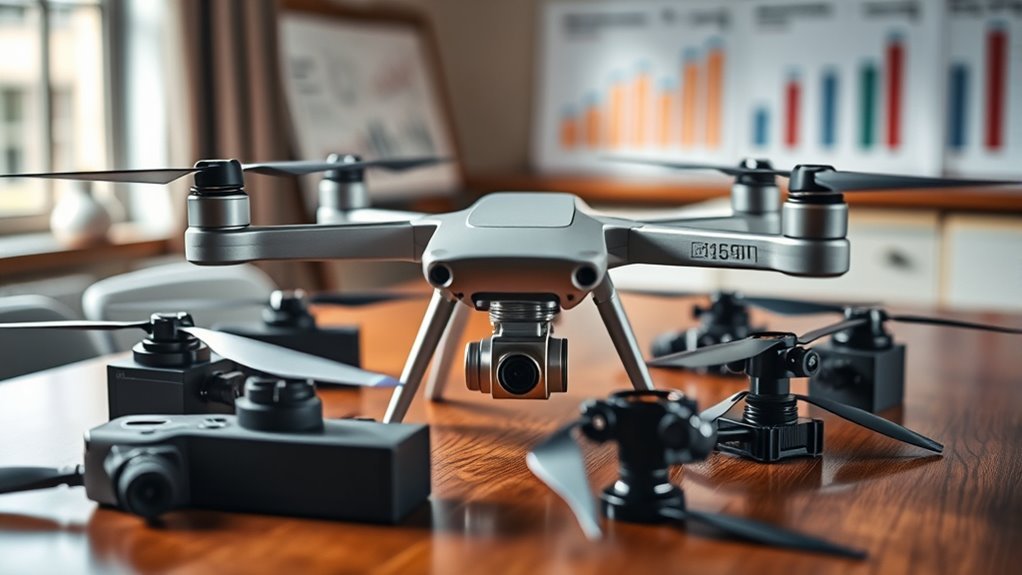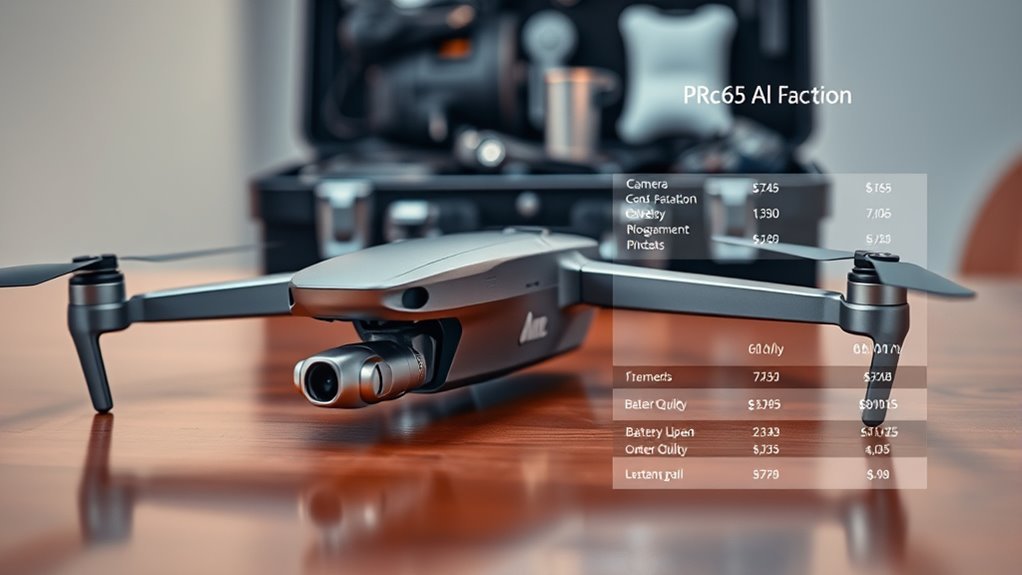Three key factors influence how much commercial drones cost: specifications and features, regulatory compliance, and market demand. The quality of the camera, flight range, and advanced features directly affect pricing. You need to be aware of local regulations and certification processes, as these can incur additional costs. Finally, market trends and competition shape pricing strategies among manufacturers. Understanding these factors can help you make informed decisions as you explore your options.
Drone Specifications and Features

When evaluating commercial drones, you’ll find that specifications and features greatly impact costs. Key aspects like camera quality and flight range play a pivotal role in determining a drone’s price. High-resolution cameras offer superior image clarity, essential for applications such as surveying or inspection. Conversely, drones with basic cameras may suffice for simpler tasks, reducing costs. Similarly, flight range is vital; models with extended ranges allow for more versatile operation, enabling you to cover larger areas without needing to recharge frequently. However, these advanced features often come at a premium. For example, the Teal 2 offers a 7km LTE range, which can enhance operational flexibility. Balancing your need for enhanced camera quality and flight range against budget constraints will help you make informed decisions, ultimately ensuring you select a drone that aligns with your operational needs and freedom to explore. Additionally, features such as obstacle avoidance systems can further enhance safety and operational efficiency, influencing overall cost.
Regulatory Compliance and Certification

Although understanding regulatory compliance and certification may seem challenging, it’s essential for anyone looking to operate commercial drones. Maneuvering these regulatory hurdles is crucial to avoid costly fines and guarantee safety. Here are four key points to take into account:
- Know the Regulations: Familiarize yourself with local and national laws governing drone usage, including airspace classifications that dictate operational areas.
- Certification Processes: Understand the specific certification processes needed for your drone type.
- Insurance Requirements: Assess any insurance mandates that may apply to your operations.
- Operational Limits: Be aware of restrictions regarding where and how you can fly. Additionally, employing AI-driven tools can help predict and respond to regulatory changes in real time, ensuring compliance and enhancing operational efficiency.
Market Demand and Competition

Regulatory compliance sets the stage for understanding the broader landscape of commercial drone operations, where market demand and competition play essential roles in shaping costs. To navigate this environment, you need to keep an eye on market trends that influence consumer preferences and technological advancements. As demand for commercial drones increases, manufacturers adapt their pricing strategies, often leading to price fluctuations that can impact your purchasing decisions. Competitors in the market will also refine their offerings to meet rising expectations, which can either elevate or lower costs depending on their efficiency and innovation. Notably, Coretronic’s innovations are reshaping market dynamics and influencing pricing strategies across the board. Ultimately, understanding these dynamics is essential for making informed decisions that align with your operational needs and budget constraints. Furthermore, manufacturers must consider NDAA compliance as it increasingly becomes a factor that influences production costs and market access.
Frequently Asked Questions
What Are the Maintenance Costs Associated With Commercial Drones?
When evaluating maintenance costs for commercial drones, consider repair frequency and parts replacement. Regular upkeep can minimize downtime and enhance performance, ensuring you maintain operational efficiency while enjoying the freedom drones offer in various applications.
How Do Warranty Options Impact the Overall Cost?
Warranty options can greatly impact overall costs. You’ll find that extensive warranty coverage may raise initial expenses, while extended warranties can offer long-term savings, ensuring your drone remains operational without incurring unexpected repair costs.
Can Software Subscriptions Increase the Total Cost of Ownership?
Imagine a painter’s canvas; if you pay more for premium colors, your art shines brighter. Similarly, software features in subscription models can inflate your total cost of ownership, impacting your drone’s value and performance over time.
Are There Financing Options Available for Purchasing Commercial Drones?
Yes, there’re financing options available for purchasing commercial drones. You can explore drone leasing agreements or various financing plans that allow for manageable payments, enabling you to acquire advanced technology without a significant upfront investment.
How Do Battery Life and Replacement Affect Long-Term Expenses?
Imagine your drone as a race car; its battery technology and energy efficiency determine how far it can go. Poor battery life means frequent replacements, driving up your long-term expenses and limiting your freedom to soar.

